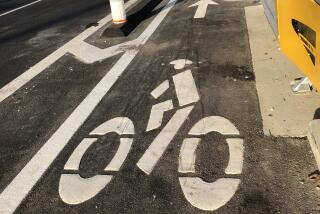Pedaling Peddler : Autobike’s President Is Geared Up to Market Self-Shifting Cycle
- Share via
ANAHEIM — What next, anti-lock brakes? Rack-and-pinion steering? From the effort-phobic nation that brought you electric toothbrushes and books on tape comes the world’s first mass-produced, self-shifting, automatic-transmission bicycle, and life above the handlebars may never be the same.
“It truly is revolutionary!” says Fred Snyderman, the only man in the world who doesn’t mind being called “shiftless.”
As president and CEO of CSA Inc., which makes and markets the all-new Autobike, Snyderman is peddling his wunderproduct hard this week, confronting skeptics and proselytizing purists at the 1995 Interbike International Bicycle Expo, being held through today at Anaheim Convention Center.
Clearly Snyderman is a man psyched about his bike, stoked about his spokes, and he doesn’t care who knows it.
“It’s the same as the automatic teller,” he says. “How about the automatic camera, you have one of those?”
Indeed, many visitors who stop by Snyderman’s booth acknowledge that, yes, they do use self-focusing cameras and machines that dispense money.
Well, Snyderman says, the Autobike is just another in a long line of products demanded by a culture that’s fanatic for the automatic.
“The line we always hear from people is, ‘Why hasn’t anyone done this before?’ ” says Brian Hawkins, CSA’s marketing director.
(In fact, someone has. But more on that later.)
As potential customers stop and examine the Autobike, Snyderman mounts one of the many stationary models on display and pedals as if a big dog were chasing him.
With a smooth clicking motion, the bike shifts itself into different gears as the wheels gain speed, and Hawkins announces:
“Our tag line is, Don’t give in to gear pressure!”
The technology behind the tag line looks oddly complex for that fairly crude, foot-propelled conveyance favored by paperboys. But perhaps there’s always room for improvement, and maybe the time was ripe for someone to put the meddle to the pedal.
Basically, it works this way:
Centrifugal force on the back wheel drives weights that push out toward the rim, thus activating the derailleur.
*
In other words, going uphill or down, speed does much of the work for you, which frees your hands, eliminates unsafe distractions and eliminates the guilt you’ve always felt about using only three of your bicycle’s 21 gears.
“How many 21-speed cars do you know of?” Snyderman asks rhetorically.
With its six automatic gears, the Autobike sells for $300 to $500, depending on how many fenders, baskets, bells and other gizmos come attached.
Control freaks and hard-core bikers are expected to look down their noses at the product, Snyderman says, but couch potatoes and retirees might embrace it.
This year alone, Snyderman expects to sell 350,000 Autobikes, thanks to an aggressive marketing strategy best outlined this way:
Infomercials, infomercials, infomercials.
“Inside of 120 days,” he vows, “you will see our show, whether you want to or not.”
Just then, a prospective convert comes upon Snyderman’s booth.
Tentatively, the man hops aboard an Autobike and begins to pedal.
As the bicycle shifts into a succession of different gears, the man wrinkles his nose as if he’s caught wind of a rotten egg.
“A true cyclist wants control of his bike,” says the man, a bicycle dealer from Quebec named Robert Vyncke. “You want to extend the feeling from your body into the machine.”
*
But true cyclists are a tiny part of the market, Snyderman tells him.
“The people we’re targeting,” he says, “don’t even know they want a bicycle.”
Next comes a bicycle historian, to put this whole automatic transmission thing into some perspective.
Actually, says Carl Burgwardt, vice president of the Burgwardt Pedaling History Bicycle Museum in Orchard Park, N.Y., there have been many automatic bicycles over the years.
Most failed, he says, because they were “overmarketed and underdesigned.”
If Snyderman has found the right combination of engineering and mass production, Burgwardt promises, the day is not far off when the Autobike will have its own corner at the museum.
“Why not an automatic bicycle?” the curator says. “The bicycle is what started cars. Without bicycles there would have been no cars.”
Now that’s the kind of talk Snyderman likes.
“The vast majority of cars are automatic and they always will be,” he says. “They always will be. Until the next thing comes along, which is, who knows? Voice-activated.”






